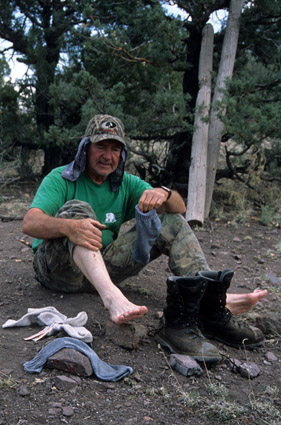 Good foot care helps you hunt harder and longer. |
Countless bowhunts come to a sad end due to ruined feet. Bowhunting the rough-and-tumble West, in particular, means first keeping feet safe and comfortable. If feet become blistered or bruised, you won’t hunt as hard as the country demands. Wreck your feet and you may not be hunting at all.
Invest In Quality Boots
Choosing a boot design for the conditions is highly important. Every hunt is different, from hot-weather pronghorn to stalking elk or mule deer, backpacking in mountainous terrain to chasing Arctic moose or caribou. Ample ankle support is important, and so is keeping feet dry when it’s wet, keeping them warm when it’s cold, or keeping them cool when it’s hot. Good hunting boots can provide all or a combination of these protections, but not always.
Quality boots are a real investment. Avoid lightweight models for mountain hunting, unless stalking stealth is more important than ankle support. Purchase hunting boots where a trained employee can fit you properly. Do not mail order unless you know the exact size and brand that accommodates your unique feet.
Break In Boots Before The Hunt
Thoroughly break in hunting boots before subjecting feet to punishment. You need to do more than wear them to the office a few days or while mowing the lawn. Fill new boots with warm water and allow them to soak overnight. The following day drain and wear them with a heavy pair of socks until they are dry. (This may take several days.) This helps them conform to your feet. After they are dry, apply a preservative with silicon; bee’s wax or mink’s oil should be added.
Choose The Right Socks
Proper socks are just as important. Standard-issue cotton guarantees sore feet. Choose polypropylene, dual-density fleece, no-itch Merino wool. Look for padding plus wicking action. Remember, anything worthwhile will cost $15 to $25 per pair.
Thin, tight-fitting liner socks are also worthwhile. Sheer silk or poly cling to feet and prevent heavier, padded socks from chafing. When socks become worn or lose, replace them.
Extreme conditions may require waterproof socks with Gore-Tex or Seal Skinz. Even waterproof boots can flood after crossing creeks, or they may fill up during heavy rains. Keep your feet dry at all costs. Stash spare socks in your daypack, and change them any time feet become wet.
Clean And Care For Your Feet
Blisters are the biggest problem. They’re painful, but can also become infected. Carry moleskin and apply to “hot spots” before they become blisters. Athletic tape may be necessary to secure it to tough spots such as heels and the ball of the foot. Duct tape serves in a pinch.
Keep toenails properly trimmed also prevents problems. Cut straight across the top to prevent in-grown toenail pain. Clean feet are also less apt to suffer problems. Wash feet often and dry them well before donning fresh socks.
Prevention is always the best medicine. Choose proper boots and quality socks, break in boots thoroughly, and head off hot-spots before they turn to hunt-ruining blisters. Happy feet translate into a happy hunter, hunters who hunt longer and harder and bring home the biggest game.






